Grackles are well-known noisy blackbirds with a rainbow sheen of iridescent feathers. They are common in the United States, and because their appetite for crops is so large, they are considered pests by agriculturalists, but what do grackles eat exactly, and do they really eat meat? Let’s find out.
What’s a Grackle?
The common grackle (Quiscalus quiscula) is native to North America and migrates in the short term to Mexico and Canada. It’s a large black bird that was first described by Carl Linnaeus in 1758 and placed in the Icterid family by French ornithologist Louis Jean Pierre Vieillot in 1816.
There are three subspecies of grackle:
- The bronzed grackle
- The purple grackle
- The Florida grackle
Grackles tend to live near woodland edges, farmland, and marshes in dense trees with nearby open countryside. They spend a lot of time making noise because they are social birds that live in huge flocks. Experts estimate there are 69-71 million grackles in the U.S.
They are common birds with pretty feathers with a bronze, purple, or green iridescent sheen, depending on their species. All grackle species have long bills and sharp golden eyes capable of spotting food from a distance.
Grackles are large blackbirds around 11-13 inches long and 2.6 to 5 ounces heavy, although females are smaller and juveniles are brown with darker eyes. They can reach 39 mph top speed and live for 5-6 years if they are not caught by predators first.
So, now we know what grackles are, let’s find out what grackles actually eat.
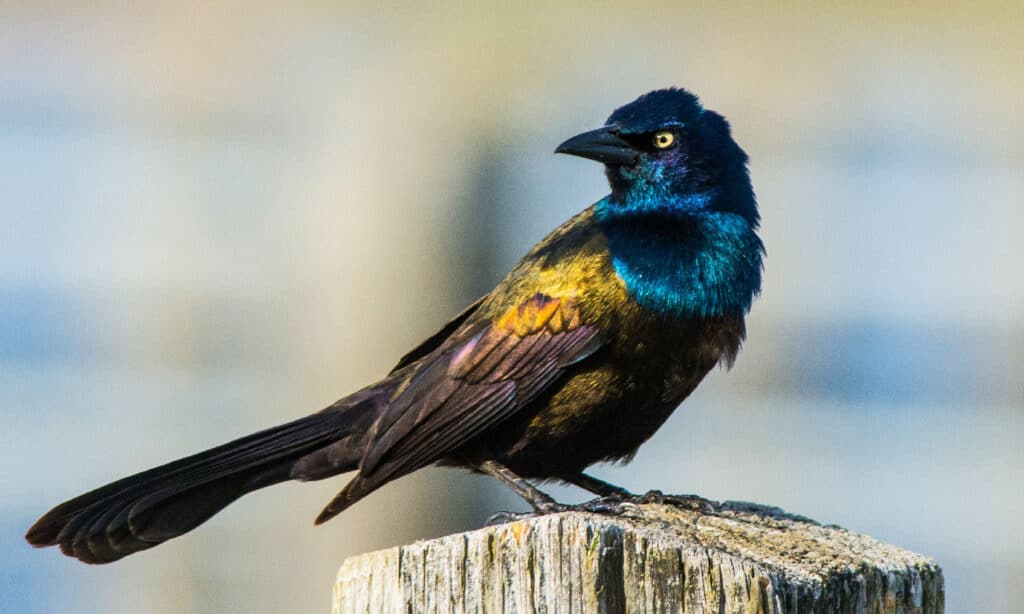
Grackles have an iridescent sheen, long bills, and sharp golden eyes capable of spotting food from a distance.
©JoshCW Photo/Shutterstock.com
What Do Grackles Eat?
Grackles are omnivores, which means they eat a lot of different foods.
Their natural food source is primarily insects, including millipedes, caterpillars, grasshoppers, spiders, and beetles that they forage for after grass-cutting. Still, they also eat worms, rodents, fish, amphibians, lizards, and other birds’ eggs. Grackles are not averse to eating meat. They follow farm plows for disturbed mice and will pick over most carcasses.
Grackles also eat grains, berries, seeds, nuts, and acorns. It’s this omnivorous eat-all attitude that’s contributed to their successful species.
It’s a resourceful bird that will look for food in gardens, woodland, marshes, shallow water, shrubs, trees, and rooftops, pick leeches from turtles, and rifle through bins!
Yes, grackles will happily pick through our trash, looking for edibles! They will eat most of what we throw away, including bread, meat, fruit cores, and sweets. Scavenging grackles at a picnic are a common sight in parks.
Clever grackles don’t just thinklessly swallow everything they find. If you’re offering dry bread crusts, be prepared to watch them dunk it in water to soften it up first! After a grackle dunks its crust, it will chatter and make soft noises until it’s ready to eat. They do the same to wash earthworms clean.
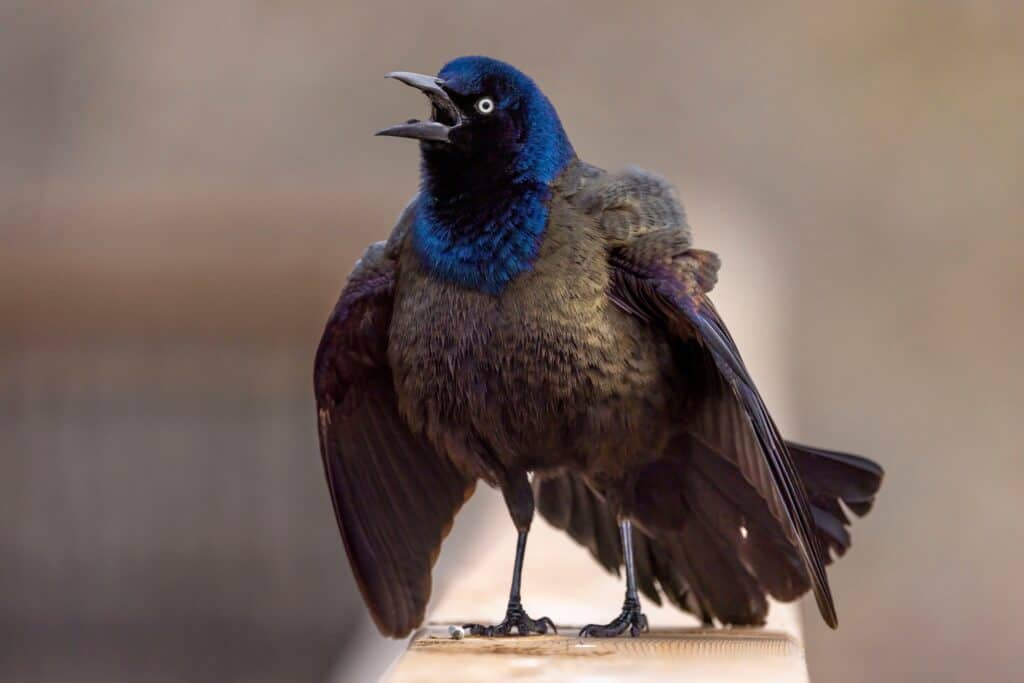
The common grackle will look for food in gardens, woodland, marshes, shallow water, shrubs, trees, rooftops, and rifle through bins!
©Kendall Collett/Shutterstock.com
Baby Grackles: What Do They Eat?
Grackle eggs are pale blue with brown blotches. The female grackle incubates them for 12-14 days, and then both parents feed their young.
The most popular baby grackle food items are insects such as butterflies, grasshoppers, craneflies, beetles, and caterpillars. Insects contain lots of energy, so baby grackles are ready to join the flock after 16-20 days. Youngsters are often seen emulating their parents in fields and begging for food.
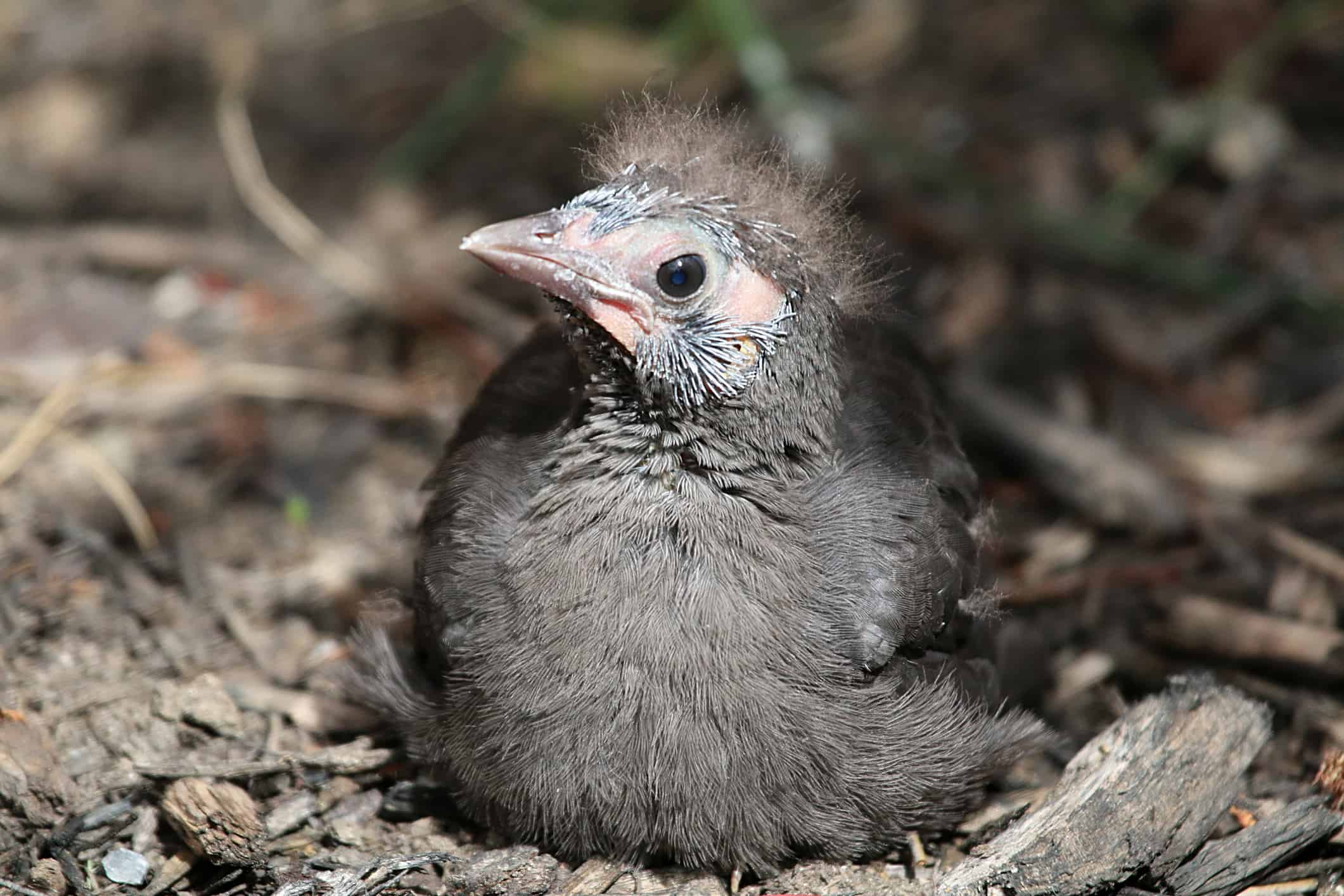
The most popular baby grackle food items are insects such as butterflies, grasshoppers, craneflies, beetles, and caterpillars.
©iStock.com/540101324
How Do Grackles Eat Everything?
Birds are usually categorized into birds of prey that eat meat and seed feeders like finches, but some birds manage to eat both. Robins and starlings, for example, eat seeds. Still, earthworms and grackles are part of this omnivorous set.
To help them with their omnivorous diet, grackles have developed an adapted keel in their bills that’s used to crack open nuts and seeds. To make it ultra-effective, they’ve also developed larger jaw muscles.
Are Grackles Pests?
Grackles are considered pests by farmers because they eat crops and livestock feed. Grackles tend to gather near food sources, so large flocks accumulate on farmland. We know grackles eat just about anything, so they are more than happy to feast on farmers’ grain, fruits, rice, tomatoes, lettuce, and even watermelons.
They also spread pathogens through their droppings and, on some occasions, have collided with aircraft. These habits are comparable to other large scavenging birds like crows and pigeons. However, despite their pest ways, grackles are protected in the U.S. by the Migratory Bird Treaty Act of 1918.
If you want to keep them from your yard, the best way is to stop putting out food that grackles eat. Scare tactics are effective, too. Hawk statues, reflective surfaces, and other bird decoys work, but because grackles are intelligent, you will need to switch them up and move them around to keep the scares working.
Birdwatchers find placing a wire cage around a feeder that’s too small for grackles to squeeze through is an effective way to feed songbirds but deter large scavengers.
What Can I Give Grackles to Eat?
Many bird lovers don’t want grackles in their yards because they bully other birds, eat everything, and even eat the other birds! Grackles have been observed killing and eating American robins, for example.
However, if you’re a grackle lover, you could feed them healthy options such as grain, berries, and peanuts. Dry cat food is a cost-effective, meaty option. Uneaten food must be thrown away each day to avoid attracting rodents.
In return, grackles will protect your lawn from annoying insects like crane flies, mosquitoes, wasps, and even rodents. Their loud and chatty presence is enough to scare away rats, snakes, and other potentially unwanted visitors. Because they congregate in flocks, they are intimidating to cats, too.
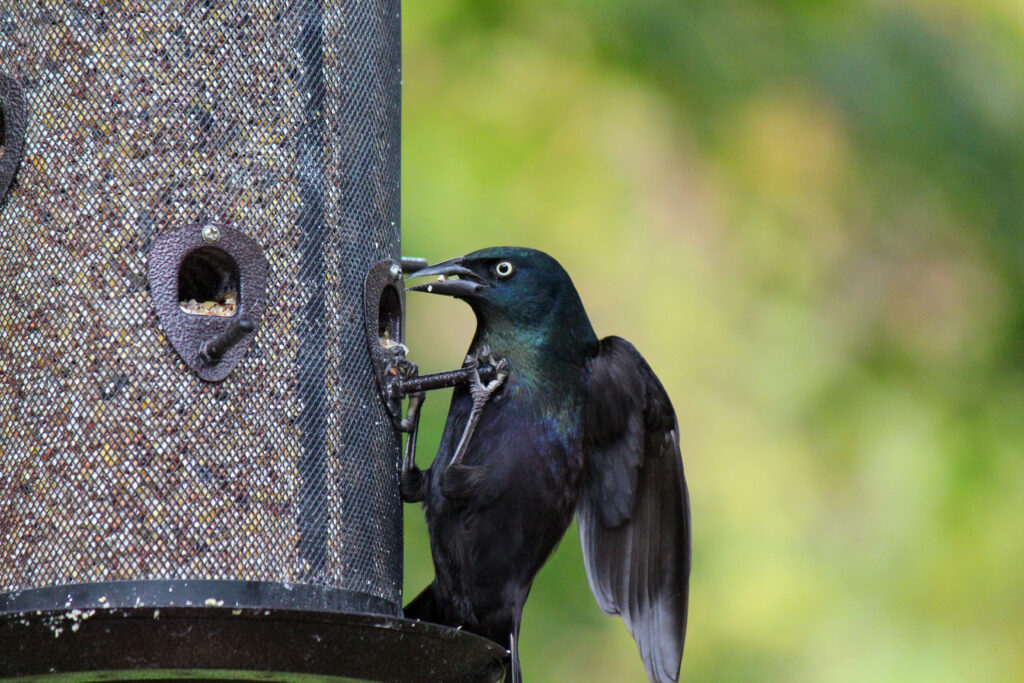
If you’re a grackle lover, you could feed them healthy options such as grain, berries, and peanuts.
©Phil Rosner/Shutterstock.com
Grackles: Do They Eat Meat?
Yes, grackles eat meat. They catch and kill frogs, lizards, mice, fish, insects, and other birds, but they are not solely carnivorous birds of prey. They’re omnivorous and eat grains and fruit, too.
What Grackles Shouldn’t Eat
Grackles will try to eat just about anything they can find. It’s best to avoid giving them high-sugar or salty food, anything with spice or chili, and drying foods like desiccated coconut.
Is a Grackle the Same as a Jackdaw?
Lots of folks can’t tell the difference between a jackdaw and a grackle, but they are different birds.
Grackles are part of the Icteridae family, and jackdaws sit in the Corvidae family. Adult jackdaws are larger than grackles, but here are some more tips to help tell them apart:
| Appearance | Grackle | Jackdaw |
|---|---|---|
| Feathers | Black with purple tinge, gray-backed neck, graying as they age | Black legs with powerful, long gray talons |
| Eyes | Golden eyes | Black eyes with white iris |
| Call | Chatter, squeaks, twitters | Chatter, shrill single call |
| Legs and feet | Long legs | Black legs with powerful long gray talons |
Why Grackles Are So Noisy?
One of the most recognizable grackle traits is their tendency to constantly make noise.
Grackle talk is not meaningless noise. Each different sound means something to the flock. A clear ‘che’ note is their mating call. Females chatter when they are nest building, and when grackles are alarmed, they give out a loud ‘chut’ or a clack.
What Predators Do Grackles Have?
Grackles might be noisy, giant birds and quite intimidating to other animals in a huge flock, but they are part of the food chain and have predators. They include:
- Raccoons
- Hawks
- Owls
- Domestic cats
- Domestic dogs
- Foxes
- Young grackles and eggs are prey for squirrels and snakes
- Humans are grackle predators despite their protected status
Recap: What Do Grackles Eat?
What grackles eat is answered in much less time by the question what don’t grackles eat!
Grackles are resourceful, intelligent omnivores that eat meat, grain, fruits, and vegetables. They pester farmers, kill, scavenge, and empty trashcans in their never-ending search for food, but although some folks don’t like their loud bully bird behavior, grackles perform amusing antics and keep your yard bug-free. They are part of the food chain and protected in the U.S.
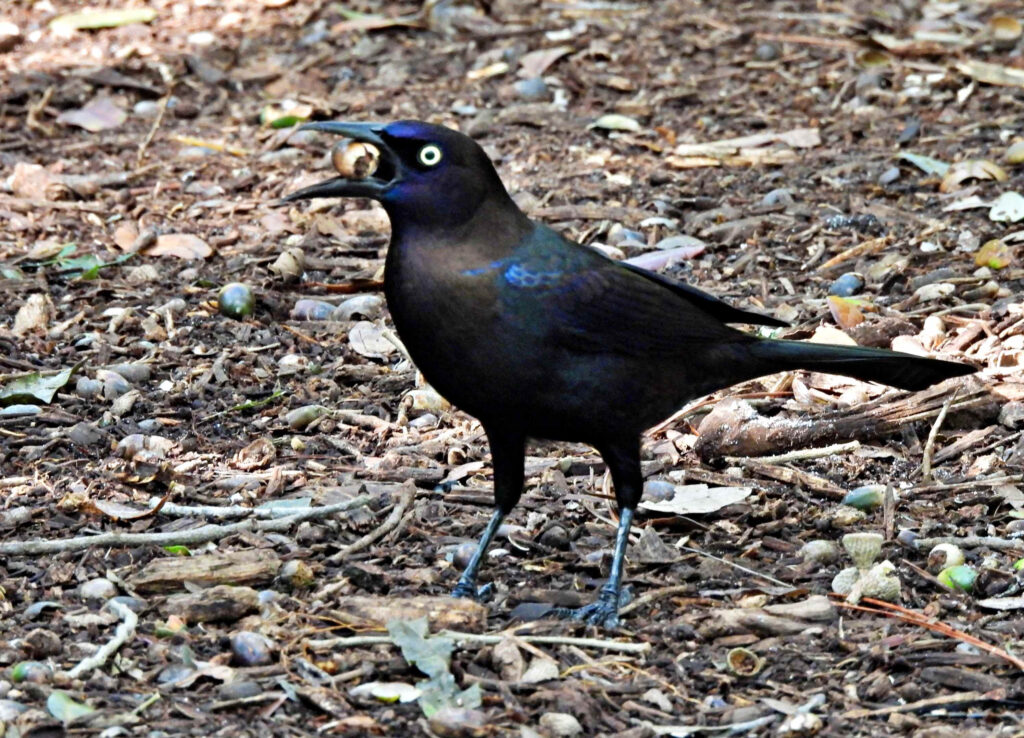
Grackles are resourceful, intelligent omnivores that eat meat, grain, fruits, and vegetables.
©iStock.com/passion4nature
The photo featured at the top of this post is © iStock.com/Christophe Merceron
Thank you for reading! Have some feedback for us? Contact the AZ Animals editorial team.






